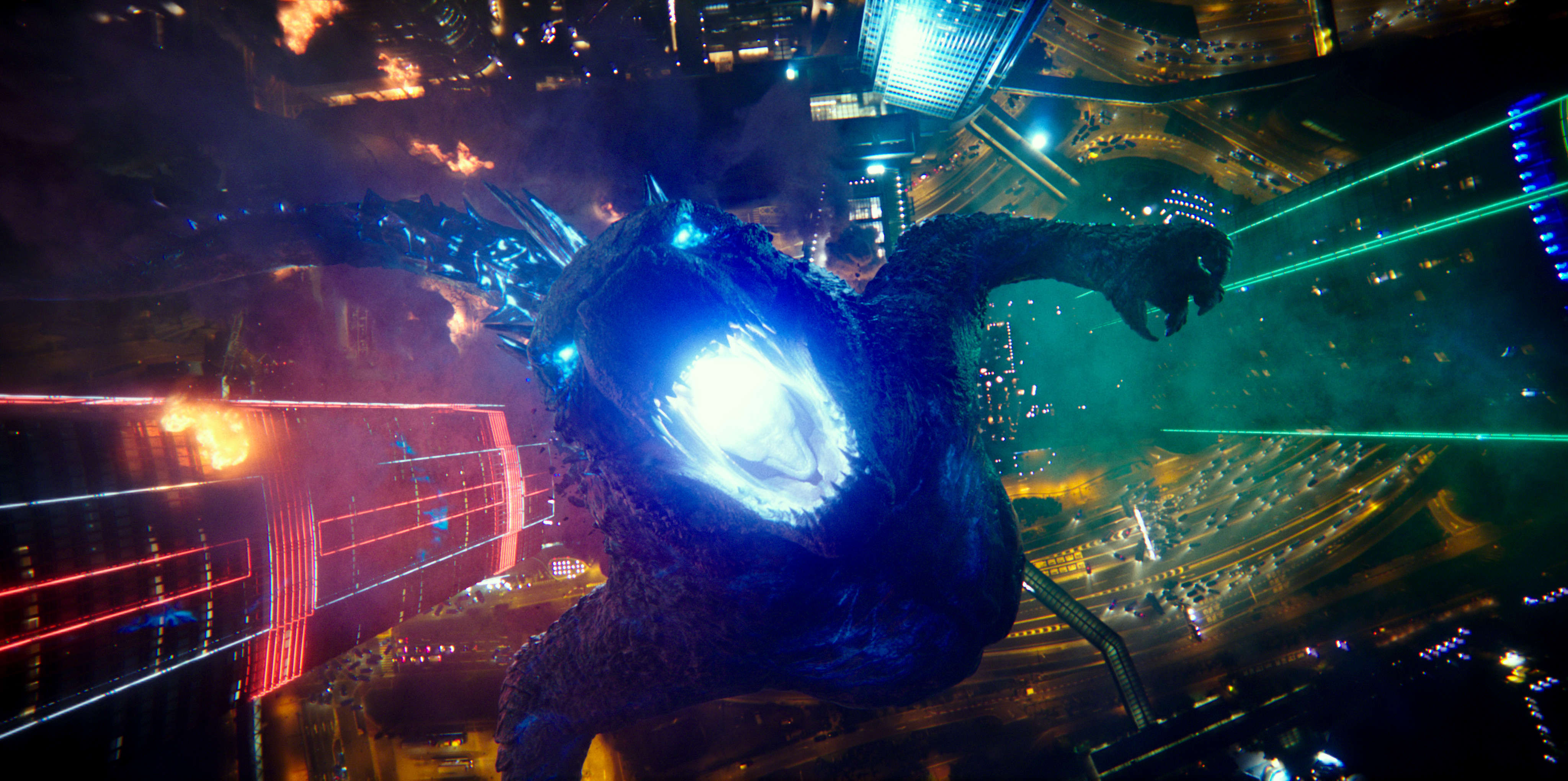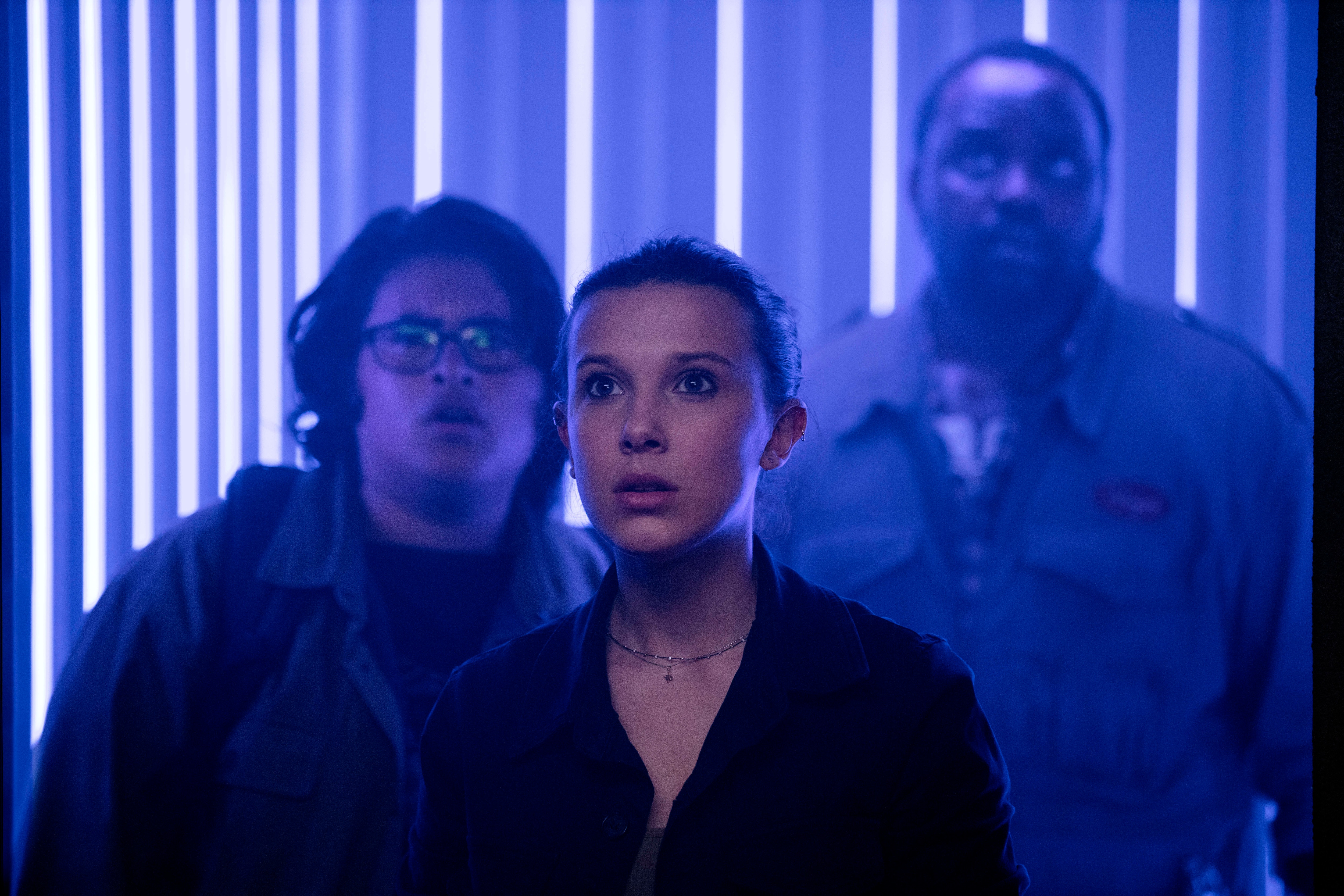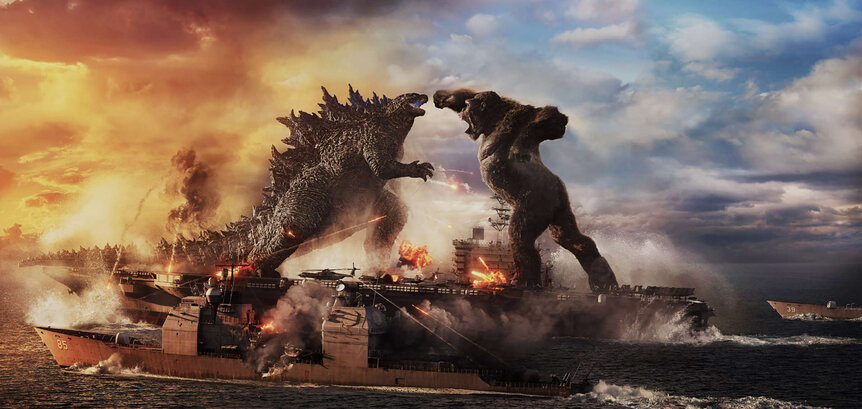Create a free profile to get unlimited access to exclusive videos, sweepstakes, and more!
Godzilla vs. Kong director Adam Wingard knows exactly why you're here: To see Godzilla fight Kong, duh

Godzilla vs. Kong is not a serious movie. Even compared to other giant monster movies, the upcoming showdown between the two most famous kaiju of all time is not, let’s say, overly concerned with being grounded in reality. Compared to the horrifying anti-nuclear themes of the original Godzilla or even the more somber gravitas of the 2014 Godzilla that kicked off the Monsterverse, Godzilla vs. Kong is unrepentantly absurd — and that’s just how director Adam Wingard likes it.
“The Showa Era of the Godzilla series is my favorite,” Wingard tells SYFY WIRE ahead of Godzilla vs. Kong’s March 31 release in U.S. theaters and on HBO Max. It’s fitting, in a way; Godzilla and Kong’s original matchup, 1962’s King Kong vs. Godzilla, was part of the franchise’s Showa Era — a period of films that started with the 1954 original and ended in the ‘70s after the series had taken a more overtly entertaining and sillier turn. One of Wingard’s favorites is Godzilla vs. The Smog Monster, arguably the zaniest the series ever got. “It’s like the Easy Rider of Godzilla films,” he says.
“I do like that the Monsterverse has slowly crept up in that direction,” Wingard continues. Godzilla vs. Kong is a movie where characters travel to the center of the Earth and back, where King Kong wields an ax in battle with Godzilla against a neon-lit Hong Kong skyline, and where one of the Showa Era’s most iconic monsters makes a surprise appearance. “I love that I was the one to kind of be able to push the series in a bit more of a Destroy All Monsters, colorful, psychedelic direction.”
Godzilla vs. Kong knows exactly what type of movie it is, in other words, and Wingard knows exactly what his role is in bringing audiences the ultimate kaiju battle.
“I’m very aware that that’s why people are coming to see this film. Even though these are some of the best actors in the world — which is kind of insane that you’d have all of them in this film, people aren’t coming to see them,” Wingard says, highlighting the presence of actors like Alexander Skarsgård, Rebecca Hall, Brian Tyree Henry, and Millie Bobby Brown, who reprises her Godzilla: King of the Monsters role. “They aren’t coming to see me as a director. They’re coming to see the stars of the movie, Godzilla and King Kong.”
With that in mind, Wingard’s eager for his film to correct one of his few quibbles with the first King Kong vs. Godzilla. Although it has some of his favorite kaiju fights, the human-centric plot of the ‘60s film “feels like a different movie than the one with the monsters.” Godzilla vs. Kong tries to avoid this by investing in its (human) characterization, sure, but it also ensures that whatever the people are doing is directly linked to what one of the two titular monsters is up to.
“We have sort of two concurrent stories and we kind of broke them into ‘Team Godzilla,’ led by Millie Bobby Brown and Bryan Tyree Henry, and then you’ve got ‘Team Kong,’ which is sort of spearheaded by Alexander Skarsgård and Rebecca Hall,” he explains. “The characters’ personalities were always based around the perspective of the monsters, and that’s why they’re relevant to the story.”
While Godzilla vs. Kong may differ from the original on a human level, some things about the rematch will be the same — including a few direct homages that both pay tribute to what came before and stand as further proof that the Monsterverse isn’t afraid to get silly. In King Kong vs. Godzilla, a drugged Kong gets airlifted into battle via a bunch of giant balloons. (The effect, a seemingly empty Kong suit suspended by what looks like leftovers from a child’s birthday party, is less than convincing, but that’s part of the Showa Era’s charm.) Wingard says that Godzilla vs. Kong features a direct nod to this moment, and what’s more, it came up organically.
“Before I went in to meet with [screenwriter Terry Rossio], I was thinking to myself ‘There’s no way I’m going to do that silly scene with Kong and the hot air balloon. That’s the one thing that I refuse to do,’” he recalls. However, there was a gap in the story. They needed a way to get Kong from one place to another. “The first thing I proposed was, ‘Well, you know, we could do like in the original film, but maybe instead of the hot air balloons, a bunch of helicopters. Is that too ridiculous?’ And [Rossio] was like ‘no, I love it.’”
Another thing Godzilla vs. Kong is taking from King Kong vs. Godzilla? Making Kong bigger so that he can give Godzilla a fair fight. The Kong from the 1933 movie stood between 18 and 24 feet tall, depending on the scene. The Godzilla of that era stood somewhere north of 160 feet tall. The Monsterverse’s Kong, who first appeared in 2017’s Kong: Skull Island, stood a much taller 104 feet, but in the half-century since that film’s ‘70s setting, he grew to 335 feet to better match Godzilla’s 395-foot stature.
“There’s just not much of a fight if you’ve got a tiny King Kong swinging on Godzilla’s tail,” Wingard admits. “That would be cute, for a minute, to see that, but the believability that there’s even a fight there is hard to comprehend.”
Even though he’s bigger, Kong is still the underdog — especially since he’s not always going to be fighting Godzilla on favorable ground. Godzilla, who lives underwater most of the time, has a definite advantage over Kong when he attacks him aboard an aircraft carrier in the middle of the ocean, as seen in posters and trailers for the film. Wingard likened Kong to Die Hard’s John McClane, who not only had to take down terrorists who outnumbered him, but also had to contend with Nakatomi Plaza and added environmental challenges like not having shoes to step over shattered glass. “I saw Kong as being sort of an ‘80s action hero type,” he says.
“I think that’s what makes battle sequences like this more interesting,” Wingard continues. “It’s not just forgettable moments of the monsters bumping into each other. I wanted you to remember specific moments, I wanted you to walk away as an audience remembering real moves.”
Audiences will also walk away with something else — another thing that the first King Kong vs. Godzilla fight deprived them of: The knowledge of who would win in a fight between Godzilla and King Kong. The first movie ends inconclusively, with Kong either retreating or walking into the sunset victoriously, depending on how you look at it. That’s very much not the case in Godzilla vs. Kong.
“When I was in second grade, I remember arguing with my friends over who would win in a fight, Godzilla or King Kong,” Wingard says. “But, just think about that for a second. In the ‘80s, King Kong vs. Godzilla had existed for a couple of decades as a movie, and here we were still arguing about it. The movie happened, but it didn’t satisfy, because it’s too interpretational about who wins.”
That’s how you get Godzilla vs. Kong, a movie that is proudly unserious about most things, but extremely serious when it comes to delivering a good and definitive fight.
“I knew it was going to be controversial in one way or another, but I knew that people were not going to be satisfied if they came in here and we chickened out and didn’t pick a stance,” he says. “From the get-go, I always felt very confident about who I thought would win and how we would pull it off.”
Godzilla vs. Kong premieres in theaters internationally starting on March 24 and opens in the U.S. on March 31, where it will also be streaming on HBO Max for one month.




























